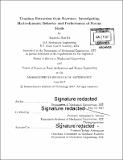| dc.contributor.advisor | . | en_US |
| dc.contributor.author | Hamlet, Amanda (Amanda M.) | en_US |
| dc.contributor.other | Massachusetts Institute of Technology. Department of Mechanical Engineering. | en_US |
| dc.date.accessioned | 2017-10-18T15:10:52Z | |
| dc.date.available | 2017-10-18T15:10:52Z | |
| dc.date.copyright | 2017 | en_US |
| dc.date.issued | 2017 | en_US |
| dc.identifier.uri | http://hdl.handle.net/1721.1/111939 | |
| dc.description | Thesis: S.M., Massachusetts Institute of Technology, Department of Mechanical Engineering, 2017. | en_US |
| dc.description | Thesis: S.M. in Naval Architecture and Marine Engineering, Massachusetts Institute of Technology, Department of Mechanical Engineering, 2017. | en_US |
| dc.description | Cataloged from PDF version of thesis. | en_US |
| dc.description | Includes bibliographical references (pages 77-82). | en_US |
| dc.description.abstract | As global economies grow and demand more energy, scientists work to develop alternative sources to meet demand. Developing countries, e.g. China and India in particular, will turn to nuclear power to meet their energy needs, increasing demand for uranium. There are enough land-based uranium reserves to cover current demand for about 120 years. However, increasing demand will shorten this estimate and require mines to tap into harder-to-extract reserves resulting in higher prices and greater environmental footprints. An unlimited supply of uranium, roughly 4.3 billion tonnes, is dissolved in the ocean at a concentration of 3 parts per billion. Chemists have been developing polymers to extract uranium from seawater to provide fuel and price security for the nuclear power industry. Coupling a system that extracts uranium with an existing offshore structure, such as a wind turbine, reduces the cost of deployment and operation as well as the overall price of uranium from the ocean. In ocean-based systems, trace metals such as uranium are passively removed via adsorbent polymers. These polymers are not inherently strong or durable, however. One solution is to enclose them in a shell structure that bears the environmental loads. This work aims to characterize the flow of water in and around porous shells containing uranium adsorbent to inform the design of a uranium extraction device. Shells with different hole patterns were fabricated and tested. The corresponding flow in and around the shells was examined qualitatively using computational fluid dynamics (CFD) and dye flow studies. The form drag of the different shells was determined experimentally and verified through CFD. The results were used to model a chain of uranium adsorbent shells submerged in the ocean and subject to various currents. The dynamic forces due to vortex-induced vibration were studied to determine resonant frequencies. Findings will be used to inform uranium extraction system design in an offshore environment. | en_US |
| dc.description.statementofresponsibility | by Amanda Hamlet. | en_US |
| dc.format.extent | 82 pages | en_US |
| dc.language.iso | eng | en_US |
| dc.publisher | Massachusetts Institute of Technology | en_US |
| dc.rights | MIT theses are protected by copyright. They may be viewed, downloaded, or printed from this source but further reproduction or distribution in any format is prohibited without written permission. | en_US |
| dc.rights.uri | http://dspace.mit.edu/handle/1721.1/7582 | en_US |
| dc.subject | Mechanical Engineering. | en_US |
| dc.title | Uranium extraction from seawater : investigating hydrodynamic behavior and performance of porous shells | en_US |
| dc.title.alternative | Investigating hydrodynamic behavior and performance of porous shells | en_US |
| dc.type | Thesis | en_US |
| dc.description.degree | S.M. | en_US |
| dc.description.degree | S.M. in Naval Architecture and Marine Engineering | en_US |
| dc.contributor.department | Massachusetts Institute of Technology. Department of Mechanical Engineering | |
| dc.identifier.oclc | 1005923554 | en_US |
